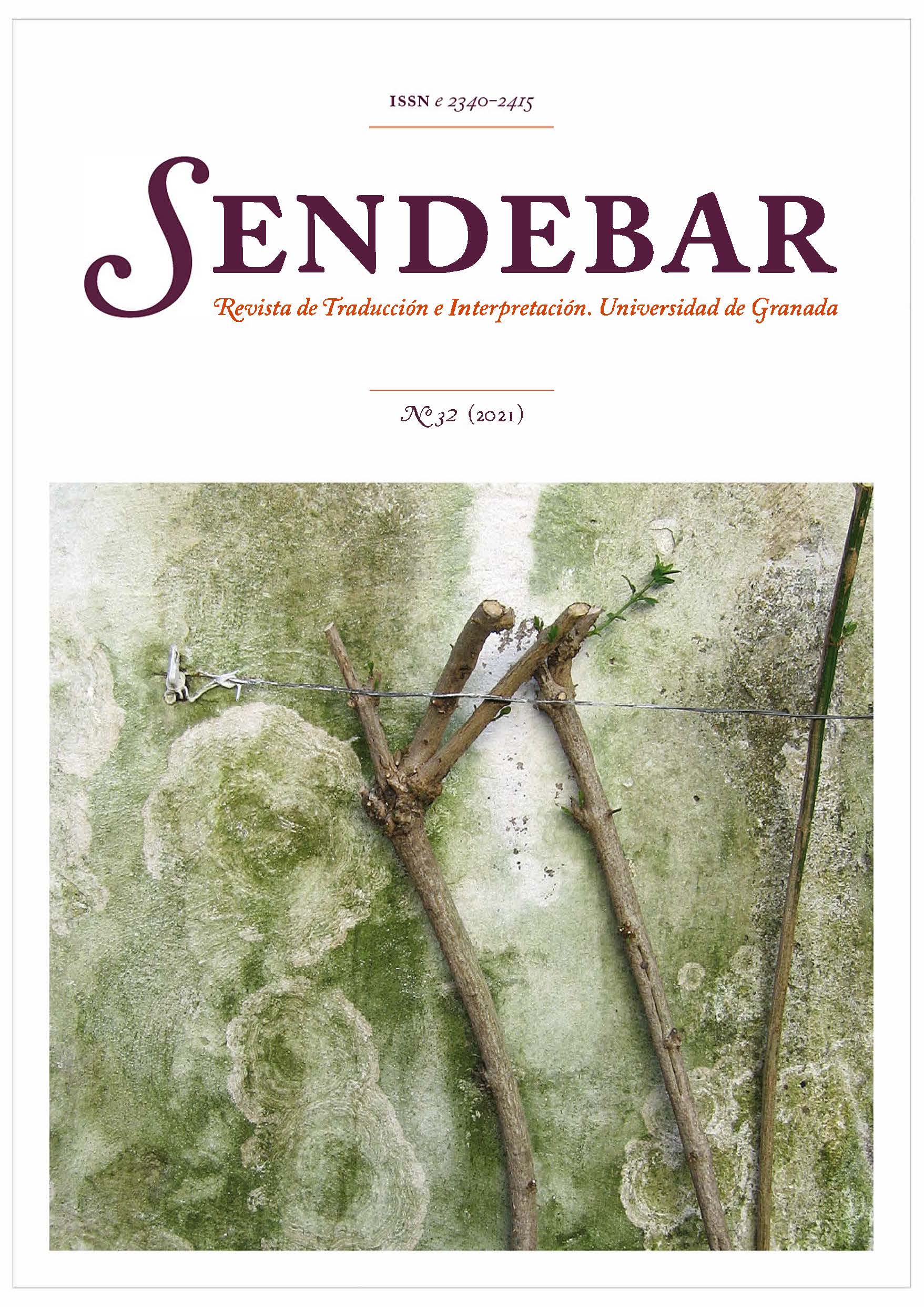La interpretación del humor verbal. Una aproximación funcionalista
DOI:
https://doi.org/10.30827/sendebar.v32.13499Palabras clave:
humor verbal, interpretación, funcionalismo, métodos y técnicasResumen
Este trabajo aborda los métodos y técnicas concretos de la interpretación del humor verbal - del español al chino y viceversa- a partir de un estudio de casos, desde la perspectiva funcionalista con miras a alcanzar la meta de una comunicación más fluida y eficaz. Para ello analizamos los criterios primordiales de la traductología funcionalista y la traducibilidad del humor verbal. Con arreglo a los principios funcionalistas y ejemplos concretos de interpretación, plantearemos tres métodos y sus respectivas técnicas: (a) Método literal: que se realizan las correspondencias en cuanto a la forma, el contenido y las funciones entre el texto original y el texto meta. (b) Método libre. Se conservan el contenido y las funciones con debidas modificaciones de la forma. Las técnicas concretas son: amplificación, compensación, aumentación y elisión. (c) Método interpretativo-comunicativo. Solo se conservan las funciones. La respectiva técnica es sustitución parcial.
Descargas
Citas
Apte, M. L. (1985). Humor and laughter: An anthropological approach. Cornell University Press.
Asscher, O. (2010). A model for Hebrew translation of British humor: Amplification and overstatement. Target: International Journal on Translation Studies, 22(2), 237-263.
Attardo, S. y Raskin, V. (1991). Script theory revisited: Joke similarity and joke representation model. Humor: International Journal of Humor Research, 4(3/4), 347–411.
Attardo, S. (1994). Linguistic theories of humor. Mouton de Gruyter.
Attardo, S., Hempelmann, C. y DiMaio, S. (2002). Script Oppositions and Logical Mechanisms: Modeling Incongruities and their Resolutions. Humor: International Journal of Humor Research, 15(1): 3-46.
Chan, Y. y Lavallee, J. P. (2015). Temporo-parietal and fronto-parietal lobe contributions to theory of mind and executive control: an fMRI study of verbal jokes. Frontiers in Psychology, (6), 1285.
Chen, H., Chan, Y., Dai, R., Liao, Y., Tu, C. (2017). Neurolinguistics of Humor en S. Attardo (Ed.), The Routledge Handbook of Language and Humor. Routledge.
Chen, Y., Wang, W. (2020). Translating English humor into Chinese subtitles: a semiotic perspective. Perspectives, 1-17.
Chiaro, D. (1992). The Language of Jokes: Analyzing Verbal Play. Routledge.
Chiaro, D. (2005). Foreword. Verbally Expressed Humor and Translation: An Overview of a Neglected Field. Humor: International Journal of Humor Research, 18(2): 135-145.
Chiaro, D. (2006). Verbally expressed humour on screen: Reflections on translation and reception. The Journal of Specialized Translation, (6), 198-207.
Chiaro, D. (2017). Humor and translation en S. Attardo (Ed.), The Routledge Handbook of Language and Humor. Routledge.
Delabastita, D. (1993). There´s a double tongue: An investigation into the translation of Shakespeare´s Wordplay, with special reference to Hamlet. Rodopi.
Figueroa-Dorrego, J. y Larkin-Galiñanes, C. (2009). A source book of literary and philosophical writings about humour and laughter. Edwin Mellen.
García-Yebra, V. (1989). Teoría y Práctica de la Traducción. Gredos.
Gómez-Capuz, J. (2002). Mecanismos del Lenguaje Humorístico. Oralia: Análisis del Discurso Oral, (5), 75-101.
Hirsch, G. (2011). Explicitations and other types of shifts in the translation of irony and humor. Target: International Journal of Translation Studies, 23(2): 178-205.
Hurtado-Albir, A. (2004). Traducción y traductología. Cátedra.
Jáuregui, E. (2008). Universalidad y variabilidad cultural de la risa y el humor. AIBR: Revista de Antropología Iberoamericana, 3(1), 46-63.
Lefcourt, H. M. (2001). Humor: The psychology of living buoyantly. Kluwer Academic.
Leibold, A. (1989). The translation of humor; who says it can´t be done? Meta: Translator´s Journal, (1), 109-111.
Nash, W. (1985). The language of humor. Longman.
Nord, C. (1991). Scopos, loyalty and translational conventions. Target: International Journal on Translation Studies, 3(1), 91-101.
Nord, C. (2005). Translation as a purposeful activity: Functionalist approaches explained. Foreign Language Teaching and Research Press.
Norrick, N. R. (2007). Interdiscourse humor: Contrast, merging, accommodation. Humor: International Journal of Humor Research, 20(4), 389-413.
Popa, D. (2005). Jokes and Translation. Perspectives: Studies in Translatology. (1), 48-57.
Raphaelson-West, D. (1989). On the Feasibility and Strategies of Translating Humor. Meta: Translator´s Journal, (1), 128-141.
Redfern, W. (1984). Puns. Blackwell.
Reiss, K. y Vermeer, H. (1996). Fundamentos para una teoría funcional de la traducción. Akal.
Reiss, K. (2004). Translation criticism—the potentials & limitations. Shanghai Foreign Language Education Press.
Shih, T. (2006). Estudio sobre la traducción del humor audiovisual en chino y español. Desde una perspectiva cultural. [Tesis de Maestría, Universidad Autónoma de Barcelona]
Tolosa-Igualada, M. (2006). De la traducibilidad del chiste, más allá de los factores perceptibles. Interlingüística (16), 1079-1089.
Tsai, C. (2015). Reframing humor in TV news translation. Perspectives, 23(4):615-633.
Vandaele, J. (1995). Describing translated humour in comedy. CETRA.
Vandaele, J. (2002). Translating humour. Routledge.
Vandaele, J. (2002). Funny fictions: Francoist translation censorship of two Billy Wilder Films. The Translator, 8(2), 267-302.
Valbuena de la Fuente, F. (2002). Humor verbal y humor de situación. Cuadernos de Información y Comunicación, (7), 381-406.
Williamson, L. y Ricoy, R. (2014). The translation of wordplay in interlingual subtitling. A study of Bienvenue chez les Chi’tis and its English subtitles. Babel, 60(2), 164-192.
Yus, F. (2017). Relevance-theoretic treatments of humor en S. Attardo (Ed.), The Routledge Handbook of Language and Humor. Routledge.
Zabalbeascoa P. (1996). Translating jokes for dubbed television situation comedies. The Translator, 2(2), 235-257.
Zabalbeascoa, P. (2005). Humor and Translation- an Interdiscipline. Humor: International Journal of Humor Research,18(2), 185-207.
Descargas
Publicado
Cómo citar
Número
Sección
Licencia
Terminos de Licencia Sendebar.

















